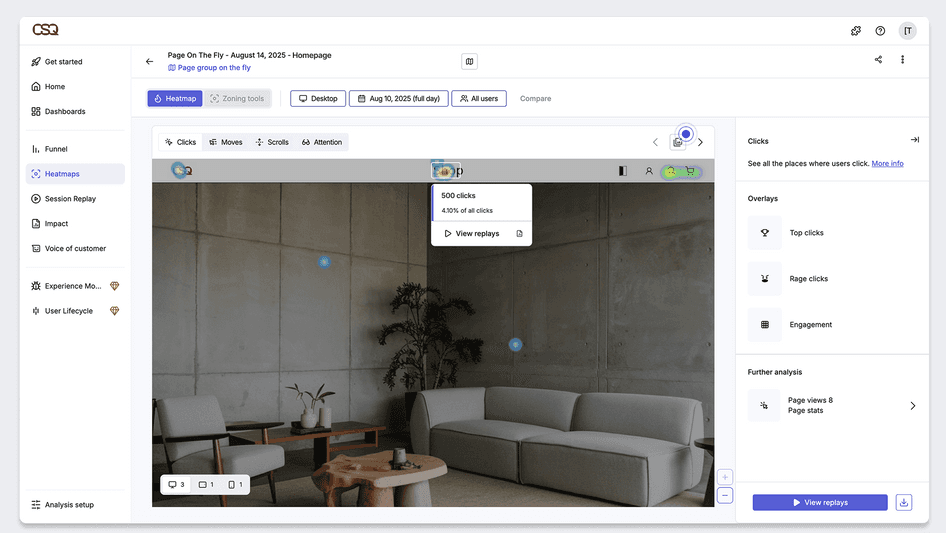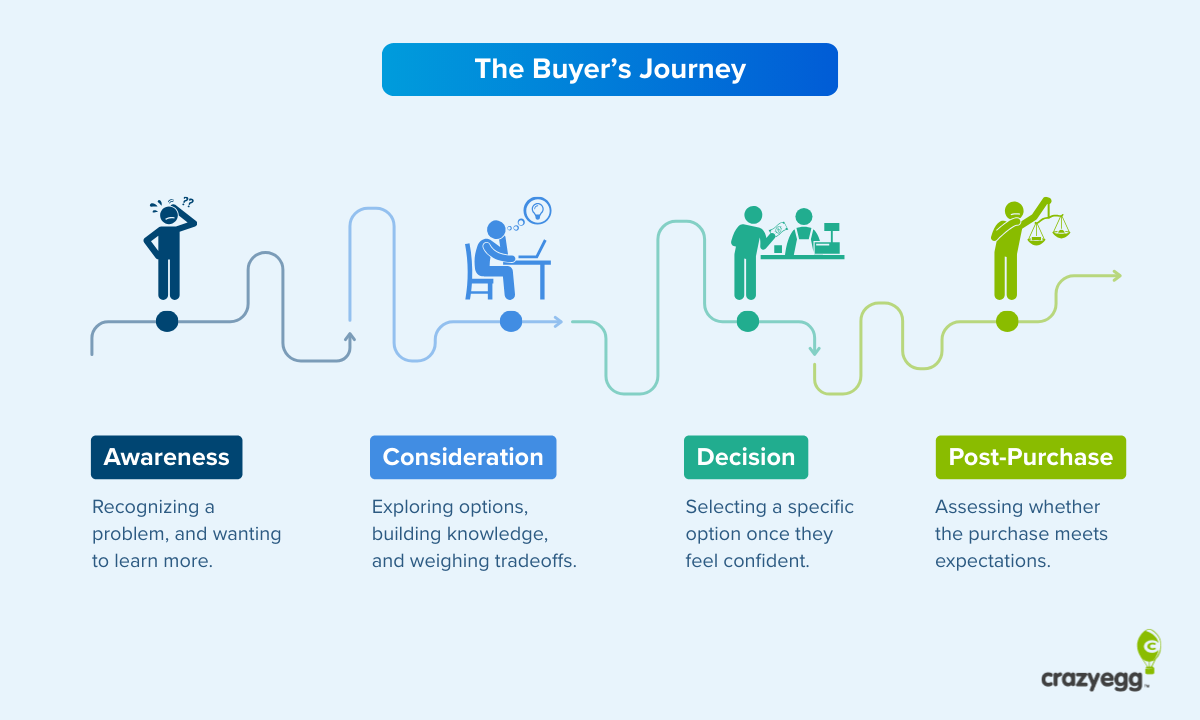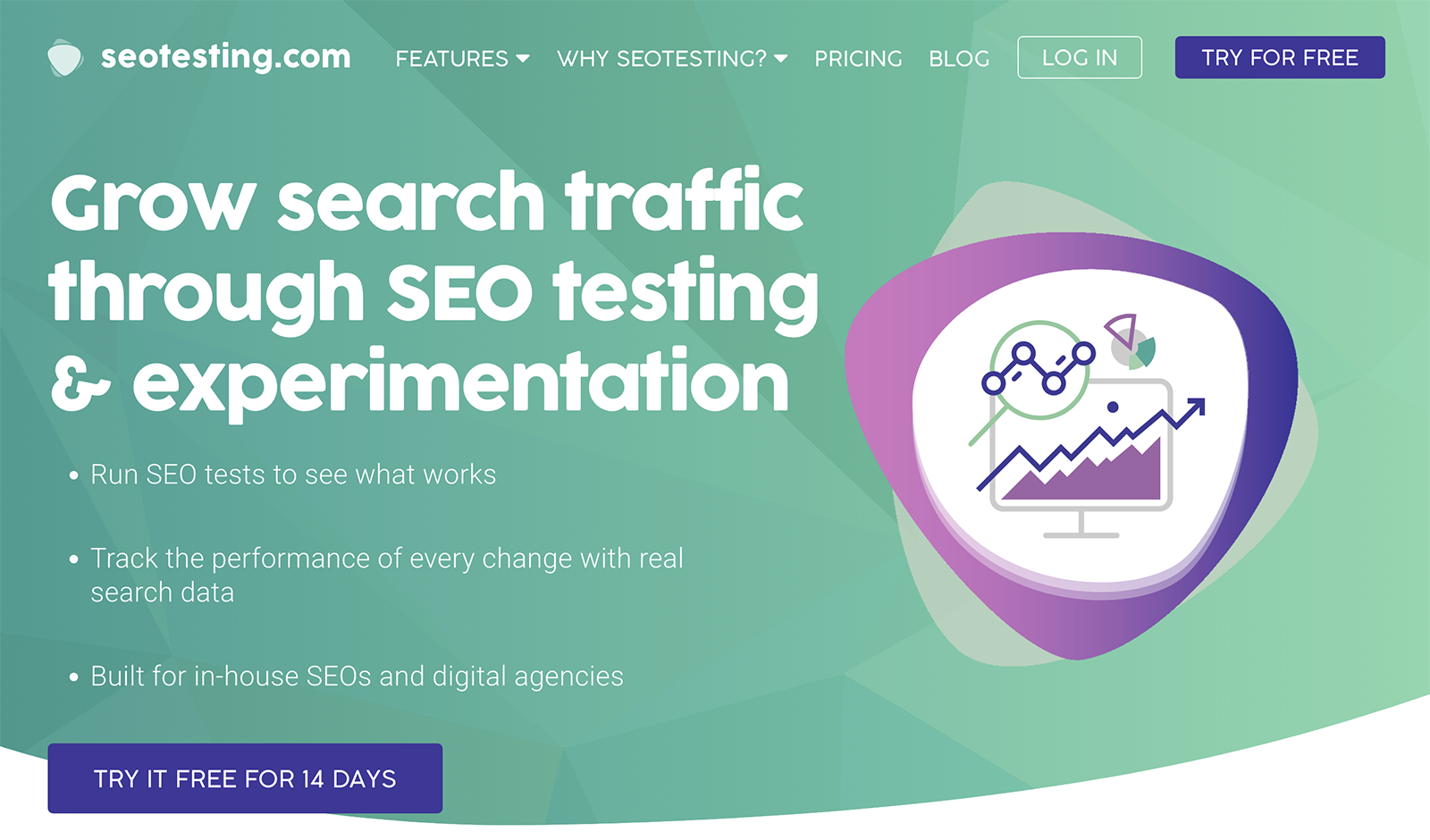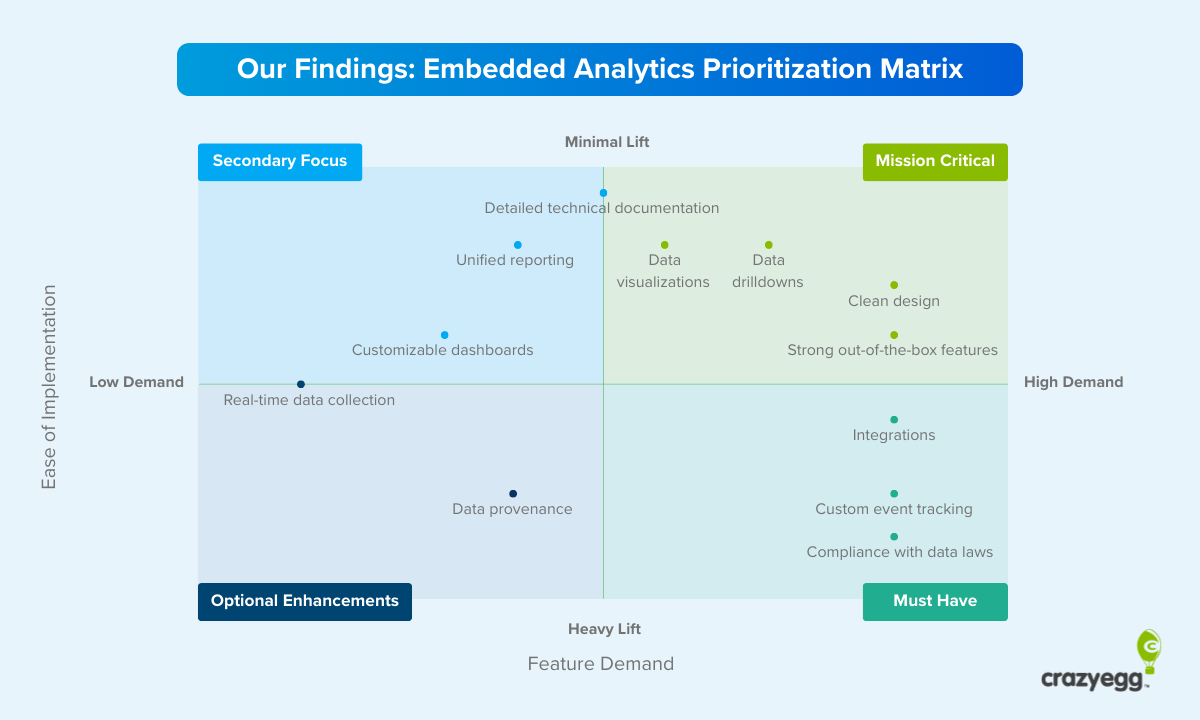When lead generation is going well, the calendar is full of appointments, and deals are closing like clockwork.
When it’s stalled, there aren’t enough leads, or they aren’t turning into sales. Talented closers are prospecting for new business instead of in the room with the decision-maker.
Here’s what you need to know to generate a long list of high-quality leads that will keep company growth going up and to the right.
What Is Lead Generation?
Lead generation (or lead gen) refers to the process companies use to attract new potential customers in their target market, collect their contact information, and follow up with them later.
Leads are people that have not bought from you yet, but have shown interest in your business. This could be calling for a free estimate, signing up for a news letter, or registering for a demo.
Generating new leads could not be more important for growing a business. It’s the start of the sales pipeline, where the murky marketing funnel results in a record of a real person and a real business who has engaged with your brand.
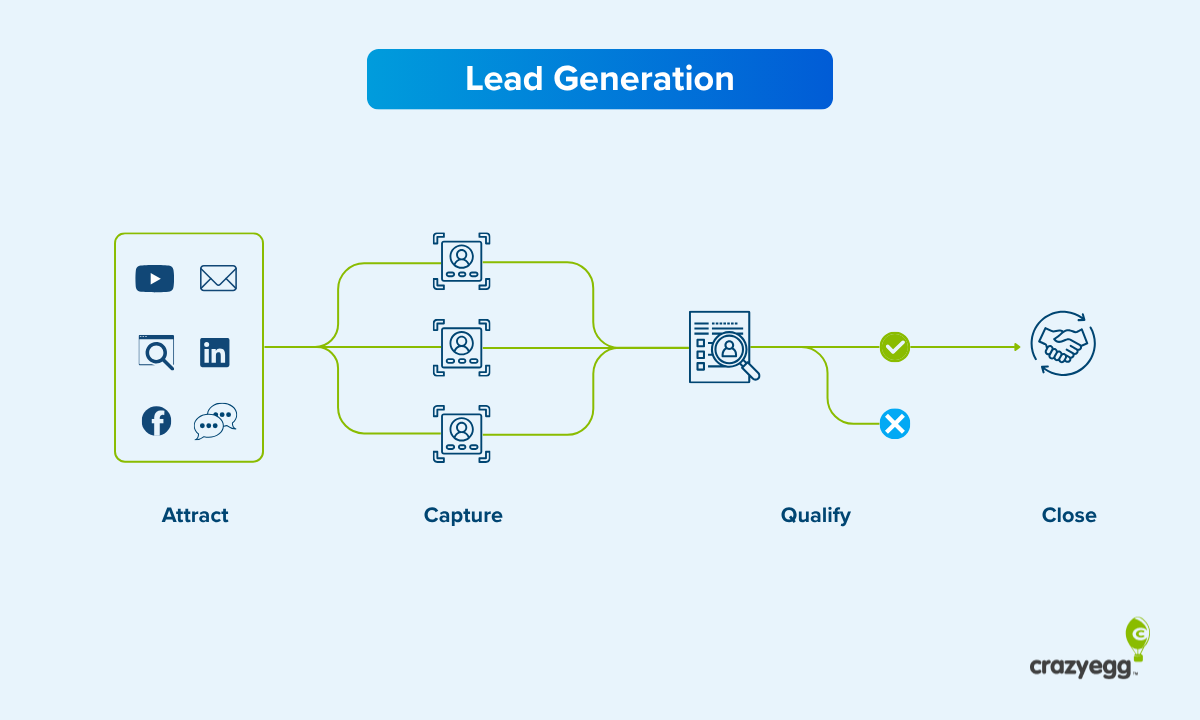
From there, you can warm them up to your products with email marketing and start to build trust. Maybe you try to get in touch directly to gauge their interest in becoming a buyer or update them on a new offering.
Not every lead is going to convert. Growing sales relies on a steady supply of new leads.
Examples of lead generation
Businesses use strategies that fit with their market and resonate with the target audience of people who are most likely to buy from them.
Let’s look at a few examples lead generation tactics I found while researching this article:
- An online store displays a popup that allows people to spin-to-win a 10%, 25% or 50% discount in exchange for their email.
- A dentist’s office runs ads on Facebook that promote a special offer for new patients who can sign up to request a call back.
- A freelance graphic designer offers a downloadable brand style guide template in exchange for an email address.
- A local contractor offers a gated PDF “Complete Kitchen Renovation Checklist” in exchange for contact information.
- A SaaS cyber security company hosts a live webinar about the latest threats and attendees must sign up using their work email.
Each one of these processes turns an anonymous website visitor into a contact record with a name, email, phone number, and potentially richer details.
Notice how the incentives (PDFs, webinars, special offers) are ONLY valuable to people that could use each businesses’ services. For example, few people will download a renovation checklist for curiosity or fun. Keeping bad-fit leads out is important.
When I clicked through on an excitingly-titled Crowdstrike webinar, for example, I was asked to fill out eight fields, including my job level and job role.
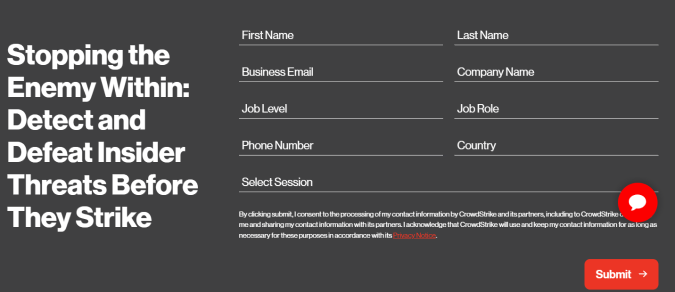
All those form fields will decrease conversions, but Crowdstrike is only interested in talking to legitimate potential customers.
Compare that complex registration process with the simple popup that greeted me on The Barrel Tap, a whiskey distributor. All they wanted was a birthday and email for a $10 discount.
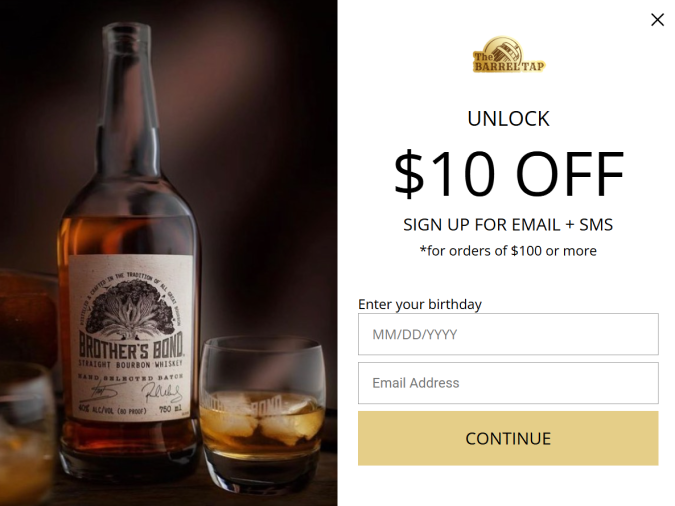
Every business engages in some form of lead generation, and as you can see from these examples, the tactics for drumming up new customers is always unique to a company’s specific market.
What’s the Difference Between Lead Generation and Prospecting?
The main difference is how you get the leads. Put simply:
- When the lead finds you, it’s lead generation.
- When you find the lead, it’s prospecting
Lead generation is typically driven by marketing teams who create content, ads, and buzz around your products to attract fresh leads.
Prospecting is driven by sales teams, who reach out to potential customers using email, DMs on LinkedIn, cold calls, and other one-to-one tactics.
The goal in both cases is to identify potential customers. Prospecting is an outbound sales activity whereas lead gen is inbound marketing.
What’s the Difference Between Lead Generation and Demand Generation?
Lead gen is where you capture the interest of potential customers, whereas demand generation is the process brands use to create that interest in the first place.
It includes all the strategies they use for raising awareness of their product, making it desirable, and getting people to engage with their brand. These strategies aren’t always focused on getting people to take action right away.
To put it as simply as possible, lead gen captures the interest created by demand gen.
How To Generate Leads ASAP: 6 Steps
In this section, we’ll cover the easiest way to create a landing page for lead generation.
If you are serious about generating a high volume of leads, landing pages are great because:
- You can drive traffic there from any channel or platform
- They are easy for for a beginner to set up and edit
- Key metrics are tracked automatically
- You might have the tools you need already
Once you set up your landing page, you can test it, improve it, and learn a lot about what your target market actually cares about.
Here’s how to get it done.
1. Identify the audience you want to reach
Who are the people that are most likely to buy from you? And why do they buy?
You probably have a good idea of who these people are, but it’s important to formalize it in writing to make sure everyone is on the same page.
A popular method is the ideal customer profile (ICP), which is a short description of the people who are most likely to need your product, pay for it, and buy it again.
The purpose of an ICP is to guide marketing efforts and maintain a consistent message. A designer, copywriter, or PPC specialist should be able to glance at the ICP and know exactly who they are trying to reach.
An ICP should also explain the reason behind the purchase. What problem do you help them solve? What opportunity do you help them take advantage of?
For B2C companies, an ICP includes demographic and psychographic data, which capture the key characteristics about who these people are and what they care about.
In B2B, an ICP will also include firmographic data on the target company size, growth rate, and tech stack.
To start defining your audience and creating a useful ICP:
- Study your existing customers. Look at purchase data, website behavior, sales calls, and support tickets. What defines your best customers who have the highest lifetime value? Where are your worst customers coming from?
- Analyze your competitors. Visit their site, take their demo, download their white paper, and dig into their keyword strategy. Who are they targeting? How are they attracting new customers?
- Research your market. Read reviews, forums, blogs, industry publications, newsletters from insiders, and view ad performance in your area or industry. What do people complain about in reviews? What do they wish were different or better about your product category? What makes people switch from one vendor to another?
- Dig into social media. Use platform metrics, social listening tools, and analyze the performance of your old posts. Who are your followers and what defines them? What’s engaging and shareable? What do people say about your brand?
2. Create a lead magnet
A lead magnet is something of value that you can exchange with website visitors for their contact information. Think: 25% discount, gated content, a free Canva template.
The best lead magnet ideas are attractive to your ICP and irrelevant to anyone else. The goal is to generate leads, not a list of random people.
For example, a company that sells home fitness equipment could offer a downloadable meal prep guide. This makes sense. Their target audience likely cares about their health and values convenience. Cooking nutritious meals in less time is a good offer.
On the other hand, people who don’t care about their health are unlikely to purchase fitness equipment, ever. They’ll scroll right by this offer, and that’s a good thing.
The better you can align your lead magnet with the desires and pain points of your ICP, the higher quality of leads you will generate. This has a positive effect on every later stage of the sales pipeline.
A convincing lead magnet offers real value, like:
- Teaching a useful skill or process
- Solving a specific problem
- Saving people time or simplifying a task
- Helping someone save or avoid wasting money
- Sharing expert insights or insider knowledge
- Offering discounts, early access, or exclusive content
3. Set up a landing page
The next step is to create a landing page that offers your lead magnet to website visitors.
A landing page is always a standalone webpage with a single purpose. In this case, the goal is to convert anonymous visitors into leads by exchanging your lead magnet for their contact information.
I recommend using a simple landing page builder that has templates you like. Check out these top-tier landing page examples for inspiration.
If you have a website already, it may include a landing page builder. Many CRMs, email marketing services, and ecommerce website builders have built-in tools for creating landing pages.
To build an effective landing page for lead generation:
- Keep the message clear: Use a strong headline, persuasive copywriting, and high-quality visuals to support a value proposition that makes sense for your ICP. Limit all distractions that could pull a visitor’s attention away from the lead magnet offer.
- Foreground social proof: Testimonials from customers, press mentions, and trust badges will help people who don’t know your brand feel more confident about starting a relationship.
- Test your lead capture and tracking system: Submit the form yourself and make sure that the contact information is captured and the follow-up triggers work, and conversion analytics are working correctly.
4. Create a followup email sequence
I suppose this is optional, but every single brand in the world follows up a lead magnet conversion with a simple email sequence. This is a low-effort, potentially high-reward way to build trust and move leads closer to becoming paying customers.
Aim for 3-5 emails that welcome the new lead and introduce them to a wider range of your products and services. A simple email autoresponder is all you need. It’s, and nearly hands-off once you get it set up.
Create this email sequence before you launch your landing page. Some tips:
- Offer unexpected value: Deliver on what you promised in the first email, but open the door to further engagement with links to additional resources, exclusive deals, or insider tips.
- Answer relevant questions: Use at least one email in the sequence to speak to an issue or problem that your audience is likely to encounter once they start using the lead magnet.
- Time your emails: Someone who just got a discount wants to use it immediately, but someone who just digested a webinar might respond better the next day. Experiment with subsequent emails to find the best time of day, day of week, and cadence.
5. Send traffic to your landing page
To get your landing page in front of website visitors quickly, you can:
- Blast the offer across social media, blogs, forums, email campaigns, etc.
- Add a discrete banner or slide-in ad on your site that links to the offer.
- Promote the offer using paid advertising tools from Meta, Google, LinkedIn, etc.
I would do a mix of all three. The best play depends on how well you can distribute the lead magnet offer on your own, and the budget you can put towards paid promotion.
If you don’t have a high-traffic site, tons of email subscribers, or a large social media reach, then paid advertising is the fastest way to promote your offer to people who don’t know your brand.
The most beginner-friendly options for buying traffic are:
- Search ads from platforms like Google Ads, which work well when your offer is a solution to a problem people are actively searching for.
- Social media ads from platforms like Meta or LinkedIn, which work well when your ICP has well-defined characteristics like interests, activities, or job titles.
- Video ads from platforms like YouTube, which work well if you are targeting mobile audiences.
- Influencer partnerships from platforms like Impact or Shopify Collabs, which can help you extend your reach through a trusted third-party with a niche following.
With the appropriate budget and in-house expertise, you can tap into affiliate networks, sponsored content, native ads, and use demand-side platforms (DSPs). There is a lot to know to use these options effectively.
If you are just starting out, I’d stick to platforms like Google Ads, LinkedIn Campaign Manager, Meta Ads, and other tools that have beginner-friendly dashboards and lots of free resources on how to use them.
Here are easy things you can do to get better quality traffic via paid media:
- Target high-intent keywords. Use common sense and SEO tools to focus your budget search terms that signal people are actively looking for solutions like yours.
- Match the ad to the landing page. Keep the message, tone, and offer consistent so visitors get what they expect.
- Take advantage of the platform tools. Use filters to target ICP characteristics to avoid wasting ad spend. Ad performance over time can help you steer your messaging.
6. Observe and make improvements
At this point, there are live users on your landing page. It’s tempting to jump in and start making changes based on what you observe in the data.
I would hold off for at least a week.
Get at least a full business cycle worth of data. Fix any typos or broken elements, but other than that I would just let it run for 2-4 weeks with minimal oversight.
Once you feel like you have enough data, it’s time to dig in, look for trends, and come up with potential improvements.
- Mind the conversion rate: A good conversion rate tells you people are finding value in your offer and that you’ve created a profitable new source of leads. A weak conversion rate is a reason to worry.
- Help users find value: Use tools like heatmaps and error tracking to figure out where users struggle. Make adjustments to streamline their experience and lower the barriers to conversion.
- Compare traffic to analyze performance: Segment traffic by source, time of day, day of week, and so on. Trends you discover can help you prioritize your ad spend and optimize your messaging to speak to your best potential leads.
- Refine the email sequence: Watch metrics like open rates, click through rates, and unsubscribes to figure out the best performing subject lines, content, or time of day to send.
Lead Scoring and Qualification
Once your lead magnet has generated a list of people that are actively interested in your business, it’s time to assess which leads are solid, which ones are junk, and which leads you need to learn more about in order to make a decision.
Simply passing the raw list of names and emails off to sales is a recipe for disaster.
Say you have a bookkeeping app. A student downloading your free budgeting template is not a lead.
Sure, the download sends a positive signal to search engines that people are finding what they need on your site, but this student is unlikely to have the urgency or means to become a paying customer any time soon.
You have to have some process for qualifying leads and making sure that they are actually a viable potential customer who is actively interested.
This is why marketing and sales teams distinguish between cold leads, qualified leads, and sometimes break the process further down into marketing qualified leads (MQLs), sales qualified leads (SQLs).
In B2B, the BANT framework is widely-used to determining if a lead is qualified or not by making sure that the they meet the following criteria:
- Budget: They can afford to buy your product.
- Authority: They can approve the purchase.
- Need: They have a real problem that your product can help them address.
- Timeline: They are looking to make a purchase during this sales cycle.
Getting this information is time-consuming. You do not want to run a full analysis on every website visitor.
In order to qualify leads quickly and objectively, businesses use a lead scoring framework that lets them objectively rank leads based on their potential to become paying customers. The higher the score, the more qualified the lead.
Lead scoring works by assigning points to things like:
- Actions like opening an email, visiting a pricing page, attending a webinar, or downloading a case study are all good signs that someone is interested in your product. A visit to the careers page, on the other hand, is a strong signal that this person is not researching your brand to make a purchase.
- Demographic traits that match your ideal customer profile, such as job title, company size, and industry. The closer the match, the more points awarded.
Leads with high scores are prioritized and pursued. Leads with low scores can be nurtured with lower-effort and less costly methods, which allows you to focus your time on the most promising leads.
Some aspects of lead scoring are done by hand, but much of it is automated using CRM software, and new AI lead scoring tools are appearing every week.
Tips for Generating Leads With Prospecting
Sometimes you have to go out and find leads.
Building a list of potential customers that fit your ICP is a lot of work, but if you do a good job, you’ll start to recognize patterns and trends that no one else has found yet.
Here are some tips to help you get started.
Use scrapers to gather business info
There are a handful of really excellent tools that let you scrape Google Maps, directories, and other public data. These scrapers let you filter by industry, geography, keywords, star-ratings, and pull relevant contact details.
In my experience, the free/cheap scrapers do not do nearly as good a job of capturing the data. You get lots of errors that lead to people wasting their time down the line.
And even the good scrapers make mistakes and pull in stale data. They aren’t perfect, but they are a great way to start generating potential leads at scale.
Data enrichment tools are essential for B2B
Public data will only get you so far. Data enrichment tools can help you find emails associated with specific people at organizations. Along with LinkedIn, you can figure out who the decision-maker is and strategize how to get in touch with them.
I have had a good experience using tools like Apollo and SignalHire. They’re not perfect, but I cannot imagine trying to run targeted outreach without an enrichment tool.
Plan to build in a CRM
It’s fine to start collecting prospects in a spreadsheet, which is messy but workable. For a little while. Don’t wait for a hot lead to fall through the cracks to make the switch.
When you start to grow (which is the goal), moving into a CRM is going to save you a ton of time and give you a rich set of automation capabilities down the line.
Be careful with purchased lists
I would avoid buying a list unless it’s a custom-built list from a firm with a spotless reputation.
This will cost a good amount of money, but that’s better than getting a cheap list, because those are junk 100% of the time.
My other word of caution with buying lists is that you miss out on the learning phase. If you outsource this step, who at your organization truly understands where new business comes from?
Understand channel regulations and limitations
If you plan to reach out to customers directly, be aware of all regulations or platform policies that could get your brand in trouble.
Phone and SMS are highly-regulated. Cold calling someone on the Do-Not-Call list can result in a heavy fine. In order to text someone, you need written consent and must include opt-out instructions. Violating the Telephone Consumer Protection Act (TCPA) will result in thousands of dollars in fines per call or text.
Email campaigns must abide by CAN-SPAM laws, which require you to include a physical address and opt-out option. You can also run into issues where your account is flagged (or blacklisted) for sending too many emails.
Direct messages on LinkedIn and Instagram are regulated by the terms of each social platform. Spamming people with messages is likely to get your account throttled or banned.
As long as you and your team know and respect the rules, you will be fine. These are all wonderful channels for prospecting. Millions of companies use them each day, safely and legally.



